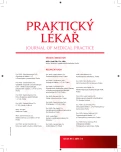Gastric surgery at present
Authors:
J. Šafránek
; J. Geiger; V. Veselý; D. Kubačková; D. Šmíd
Authors‘ workplace:
Přednosta: prof. MUDr. Vladislav Třeška, DrSc.
; Chirurgická klinika FN, Plzeň
Published in:
Prakt. Lék. 2015; 95(6): 249-252
Category:
Of different specialties
Overview
Methods:
Retrospective analysis of 146 gastric operations in 2010–2014. Only procedures performed for diseases of the stomach, not oesophagus/cardia, or adjacent organs, were evaluated.
Results:
In this period, we performed 54 gastrectomies, 61 subtotal gastrectomies and BII (large) resections, 31 BI and smaller resections, including 9 laparoscopic.
In the gastrectomy group we recorded mortality of 7.4%. The insufficiency of oesophagojejunal anastomosis has occurred in 3 cases (5.6%), in two cases treated with endoscopic stenting. The insufficiency of duodenal stump has occurred in 4 cases (7.4%). To solve resulting complications relaparotomy was necessary in 8 cases (14.8%), otherwise have been possible complications to manage conservatively.
In the group of large resections, mortality was 6.6%. The insufficiency of duodenal stump has occurred in 4 cases (6.6%), serious postoperative bleeding in one case, as well as colon perforation, and the insufficiency of the anastomosis. Relaparotomy for complications was necessary in 4 cases (6.6%).
There was no mortality in the group of small resection, reoperation was required in 1 case (3.2%) because of dehiscence of the laparotomy.
Discussion:
In the spectrum of operations in the long term the stomach surgery for cancer prevails, in our group 74.7%, followed by resection for ulcer complications 11.6%, gastrointestinal stromal tumour (GIST) 4.8%. Removal of the cancer is indicated mostly gastrectomy. Subtotal resection we provided for localization of the tumour in the distal part of stomach, intestinal type of cancer. Smaller resection is performed as a palliative procedure for cancer, or for other indications. After gastrectomy we performed almost always the stapler oesophagojejunal anastomosis, after resection usually hand sewn anastomosis. Cancer makes up the majority of indications for gastrectomy, other indications make up only about a quarter of cases. The most common surgical complications after gastrectomy/gastric resection remains insufficiency of anastomosis or duodenal stump.
Keywords:
gastrectomy – gastric resection – gastric excision
Sources
1. Adamčík L, Duda M, Škrovina M, Jínek T. Komplikace a rizika chirurgie nádorů horní části zažívacího traktu (Foregut). Rozhl Chir 2013; 92: 530–537.
2. Bozzetti F, Marubini E, Bonfanti G, et al. Subtotal versus total gastrectomy for gastrin cancer. Five year survival rates in a multicenter randomised Italian trial. Ann Surg 1999; 230(2): 170–178.
3. Cunningham D, Allum WH, Stenning SP, et al. Perioperative chemotherapy versus surgery alone for resectable gastroesophageal cancer. N Engl J Med 2006; 355: 11–20.
4. Duda M, Gryga A, Dlouhý M, a kol. Chirurgie gastroduodenálního vředu v České republice. Rozhl Chir 1997; 76: 32–35.
5. Kysela P, Kala Z, Novotný I. Chirurgická léčba pacientů s gastrointestinálním stromálním tumorem. Farmakoterapie 2010; 6: 14–18.
6. Lehnert T, Buhl K. Techniques of reconstruction after total gastrectomy or cancer. Br J Surg 2004; 91(5): 528–539.
7. Selby LV, Vertosick EA, Sjoberg DD, et al. Morbidity after total gastrectomy: analysis of 238 patients. J Am Coll Surg 2015; 220: 863–871.
8. Ohashi M, Katai H, Fukagawa T, et al. Cancer of the gastric stump following distal gastrectomy for cancer. Br J Surg 2007; 94: 92–95.
9. Papenfuss WA, Kukar M, Oxenberg J, et al. Morbidity and mortality associated with gastrectomy for gastric cancer. Ann Surg Oncol 2014; 21: 3008–3014.
10. Robertson CS, Chung SC, Woods SD, et al. A prospective randomized trial comparing R1 subtotal gastrectomy with R3 total gastrectomy for antral cancer. Ann Surg 1994; 220: 176–182.
11. Sasako M. Surgical management of gastric cancer: the Japanese experience. In Daly JM, Hennessy TPJ, Reynolds JV. Management of upper gastrintestinal cancer. Philadelphia: WB Saunders 1999; 117.
12. Sinning C, Schaefer N, Standop J, et al. Gastric stump carcinoma – epidemiology and current concepts in pathogenesis and treatment. Eur J Surg Oncol 2007; 33: 133–139.
13. Šimša J, Šmejkal P. Chirurgická léčba karcinomu žaludku. Rozhl Chir 2012; 91: 446–448.
14. Tanigawa N, Nomura E, Lee SW, et al. Current state of gastric stump carcinoma in Japan: based on the results of a nationwide survey. World J Surg 2010; 34: 1540–1547.
Labels
General practitioner for children and adolescents General practitioner for adultsArticle was published in
General Practitioner

2015 Issue 6
- Memantine Eases Daily Life for Patients and Caregivers
- Metamizole vs. Tramadol in Postoperative Analgesia
- Metamizole at a Glance and in Practice – Effective Non-Opioid Analgesic for All Ages
- Memantine in Dementia Therapy – Current Findings and Possible Future Applications
- What Effect Can Be Expected from Limosilactobacillus reuteri in Mucositis and Peri-Implantitis?
Most read in this issue
- Gastric surgery at present
- Betaglucans – immunomodulatory substances in prevention and support treatment
- Commission health assessment by medical assessor committees
- Patient with abdominal aortic aneurysm – diagnostics, follow-up and treatment in the ambulance of general practitioner
